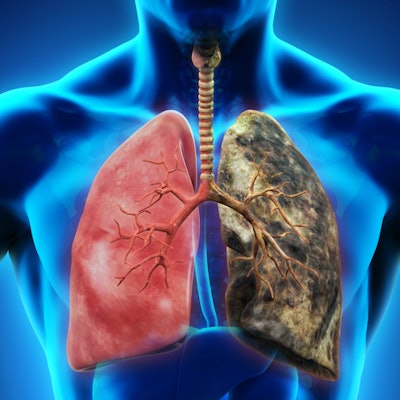
The presence of noncalcified nodules on CT lung screening exams -- including small, stable nodules -- was associated with increased cancer risk as many as 12 years after baseline screening in a secondary analysis of the National Lung Screening Trial (NLST), published in the January issue of Lung Cancer.
The researchers, led by Paul Pinsky, PhD, of the U.S. National Cancer Institute, reevaluated NLST data and tracked potential long-term risks associated with the presence of noncalcified lung nodules. They found that individuals with nodules detected on CT lung screening exams had about five times the risk of developing cancer within the first four years after the initial screening exam.
What's more, the cancer risk for these individuals was still nearly twofold greater than for people without nodules up to 12 years after baseline screening, even in cases where the nodules were small or stable (Lung Cancer, January 2020, Vol. 139, pp. 179-184).
"Noncalcified nodules identified on [CT lung screening] were predictive of lung cancer risk up to 10 or more years following the screen. ... The excess risk persisted when controlling for other lung cancer risk factors, suggesting that the noncalcified nodules themselves, at least a subset, may be lung cancer precursors," the authors wrote. "If this is the case, this sheds light on the natural history of lung cancer and its precursors."
Long-term effect
In the National Lung Screening Trial, many noncalcified lung nodules discovered during the initial CT lung screening period (which included a baseline CT scan followed by two annual follow-up screening exams) were labeled as false positives. The relatively high false-positive rate of short-term CT lung screening trials has been a point of concern repeatedly emphasized by critics of the exam.
However, recent analyses of the long-term results of CT lung screening trials have indicated that the exam offers benefits beyond the early screening period, including reductions in lung cancer deaths and false positives. Expanding upon this work, Pinsky and colleagues set out to determine whether the presence of noncalcified nodules on CT scans, many of which were initially flagged as false positives, could be indicative of cancer several years later.
The researchers examined data from the 26,309 NLST participants who underwent CT lung screening and performed separate analyses, first, for individuals who had a nodule detected on the baseline screening exam, and second, for individuals whose nodules were detected on one of the postbaseline screening exams. There were new nodules in 26.9% of the individuals during baseline screening and in 6.3% during postbaseline screening.
Overall, they found that the risk of lung cancer was much greater among individuals who had a lung nodule detected during a baseline or follow-up CT lung screening exam than in individuals without a nodule, even after controlling for other risk factors such as sex, age, and smoking history.
The lung cancer risk was roughly fivefold higher for those with a nodule than for those without a nodule within the first four years following initial screening. The difference in cancer risk was about 1.5-fold higher between four to 12 years after initial screening.
The group also discovered that distinct lung lobes that contained a nodule had a significantly greater risk of lung cancer than lobes that did not contain a nodule. For instance, lung lobes with a nodule on baseline screening were nearly 15 times more likely to develop lung cancer than lobes that did not have a nodule, regardless of whether or not the originally detected nodule was cancerous.
| Cancer risk ratios based on presence of nodules on CT lung screening | |||
| 0-4 years | 4-8 years | 8-12 years | |
| Lung cancer risk ratio for nodules found at baseline | |||
| Individuals with vs. without nodules | 5.1 | 1.5 | 1.5 |
| Lobes with vs. without nodules | 14.7 | 2.6 | 2.2 |
| Lung cancer risk ratio for nodules found after baseline | |||
| Individuals with vs. without nodules | 5.6 | 1.9 | 1.6 |
| Lobes with vs. without nodules | 19.6 | 2.5 | 3.3 |
Management implications
Clinical experience dictates that solid nodules that remain stable for two or more years are unlikely to become cancerous, so current management guidelines recommend stopping surveillance of stable nodules after two years. Yet the findings of this study demonstrated that lung lobes with a nodule that remained stable for at least two years still had about a twofold increase in cancer risk, compared with lobes without a nodule, as many as 12 years after initial screening.
The increased long-term cancer risk associated with nodules suggests the presence of cancer precursors among noncalcified nodules or that the nodules are markers for some field effect that increases lung cancer susceptibility, Pinsky told AuntMinnie.com. The excess cancer risk four to 12 years following nodule detection has potential implications for patient management.
"For example, some individuals who will age out of screening eligibility or terminate their eligibility based on 15 years having not smoked may have a stable nodule and normally not be followed up with either screening or diagnostic CT any further," he said. "However, these people have somewhat elevated long-term lung cancer risk, as compared to those with no nodules seen on CT lung screening. Therefore, the clinical question is whether these subjects should continue to be screened or otherwise monitored going forward."
Integrating risk prediction models into CT lung screening may help clinicians leverage the study's findings to determine the best approach to long-term management of individuals with nodules, the authors noted. Computer-aided detection methods such as radiomics or deep learning may further help quantify cancer risk based on findings from individual CT scans.




















